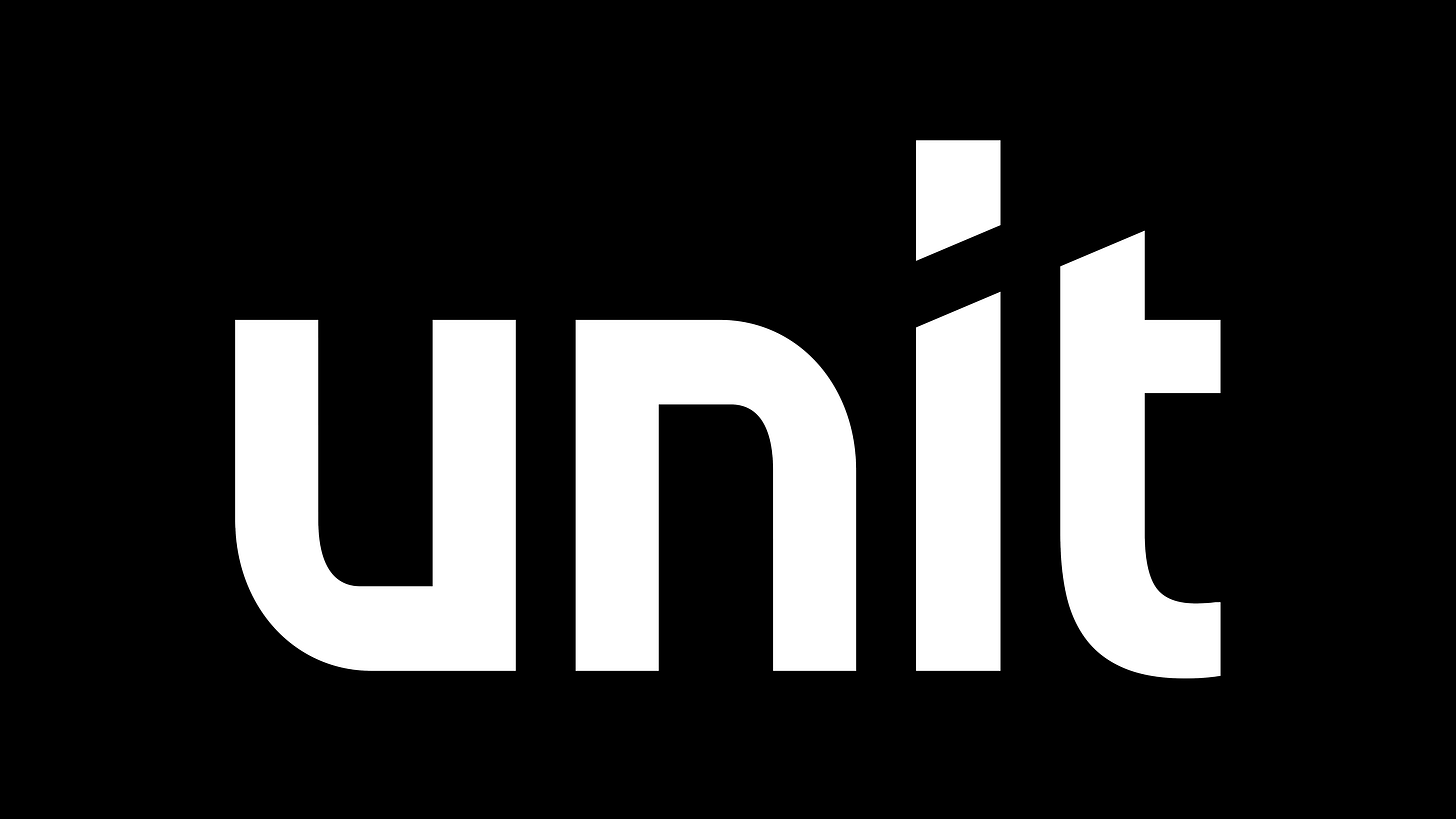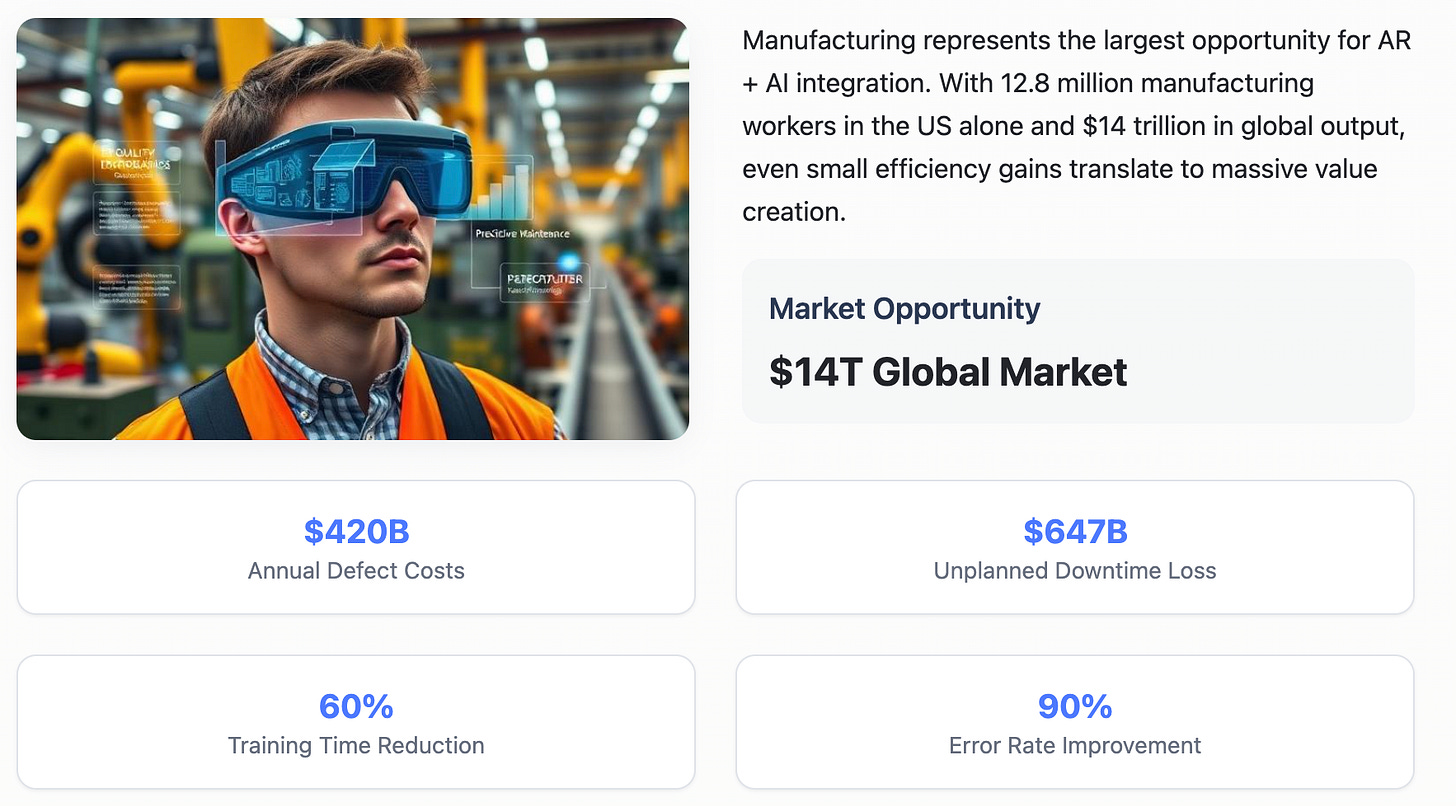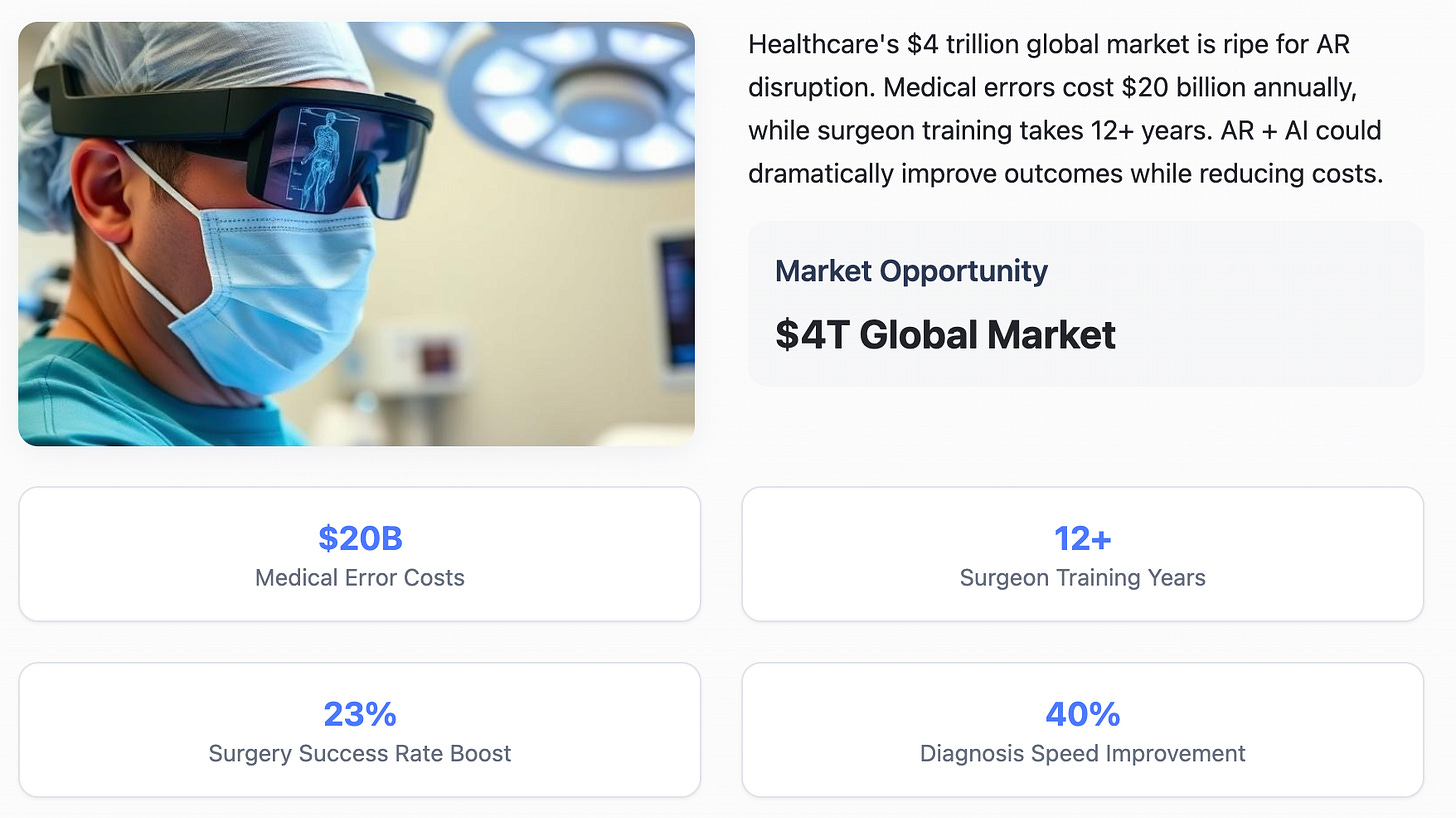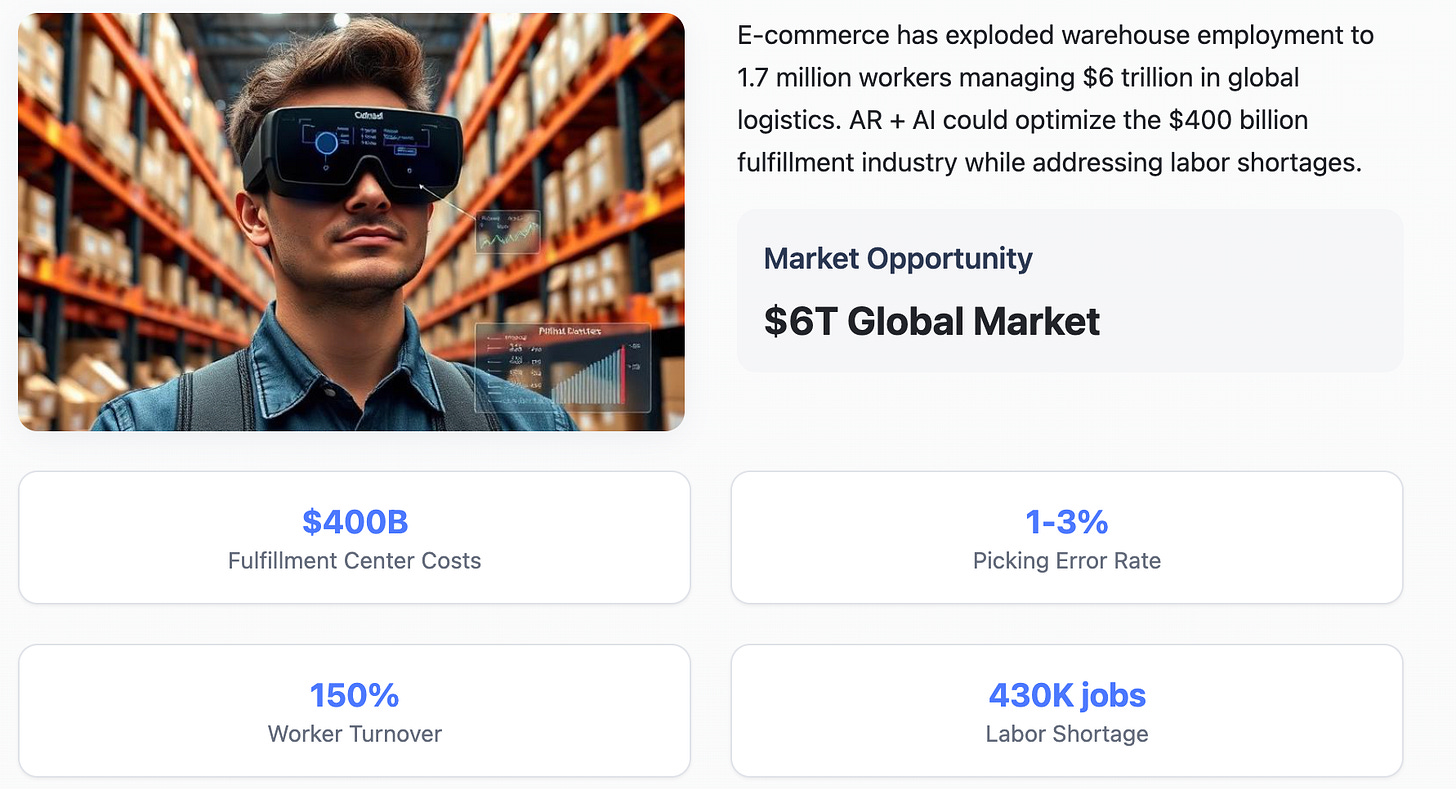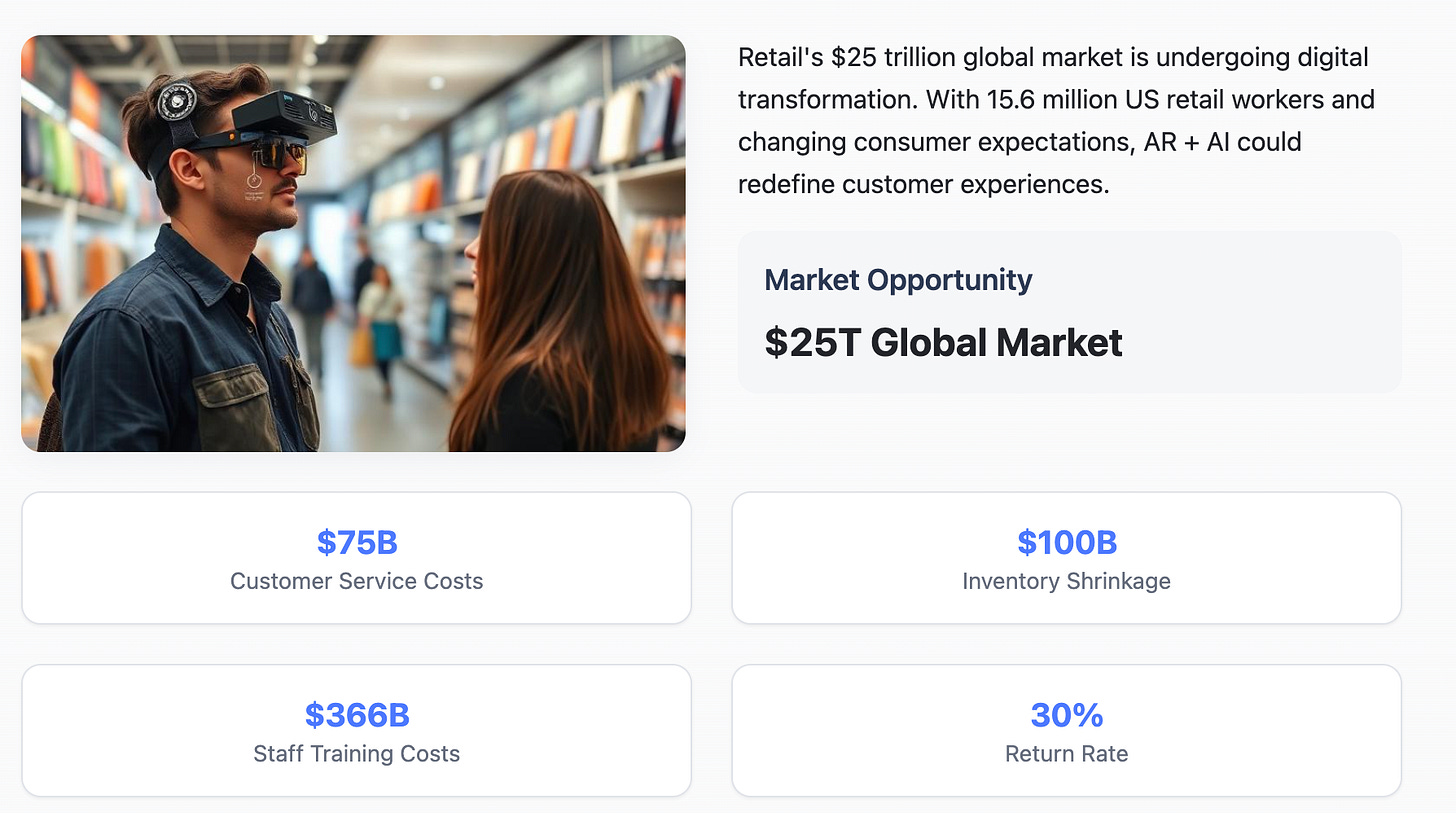Linear #144: Vertical Use Cases for Meta's New A/R Glasses, Roadshows, B2B Products ALL Eventually Converge
One vSaaS breakdown. One biz story. One 'how to'. In your inbox once a week.
Going to Stripe Tour in NYC next Tuesday?
Join Unit at the Embedded Unitverse Café, a one-day pop-up directly across from the Javits Center for anyone building in vertical SaaS. Guests can grab a barista-made coffee and connect with the teams driving embedded finance.
It’s a space for founders, product, and engineering leaders to share ideas and network - whether you’re already embedding or just starting out.
Join us on September 30.
Alright, let’s get to it…
Are Meta's AR Glasses the Hardware Consensus Moment That Could Unlock a Vertical AI Gold Rush?
Hardware has to become consensus before software can follow. We've seen this pattern with smartphones, cloud infrastructure, and now we might be witnessing it with AR. The question is: are Meta's latest AR glasses just another product launch, or could they be the consensus moment that unlocks a vertical AI gold rush?
The Hardware-First Pattern
Every major software revolution starts the same way: hardware reaches a consensus adoption point, then vertical software opportunities explode. The iPhone created the mobile app economy. AWS made cloud-native startups possible. Could Meta's AR glasses do the same for spatial computing?
But here's what most founders miss: the real opportunity isn't in the platform itself—it's in the vertical applications that could become possible if the platform reaches critical mass.
The Vertical: Opportunity Map:
If AR hardware does reach consensus, the vertical AI opportunities could be massive. Here's my deep dive into the industries with the highest potential:
Manufacturing & Industrial Operations:
Key Use Cases:
AI-Powered Assembly Guidance
Real-time visual instructions with computer vision validation of each step. Workers see 3D assembly guides overlaid on actual parts, with AI detecting errors before they become defects.
Predictive Maintenance Overlays
Machine learning algorithms analyze sensor data and display maintenance alerts, part replacement schedules, and performance predictions directly in workers' field of view.
Quality Control Automation
Computer vision systems integrated with AR glasses automatically detect defects, measure tolerances, and guide quality inspections with 99.9% accuracy.
Healthcare & Medical Procedures:
Key Use Cases:
Surgical Navigation Systems
3D patient anatomy overlaid on the surgical field with AI-guided instrument tracking, real-time vital monitoring, and predictive complication alerts.
AI-Assisted Diagnostics
Computer vision analysis of medical images (X-rays, MRIs, CT scans) with diagnostic suggestions and confidence scores displayed in physicians' field of view.
Remote Consultation Overlays
Specialist doctors can guide local practitioners through procedures using AR annotations, with AI translation of medical terminology and procedure optimization.
Construction & Architecture:
Key Use Cases:
3D Blueprint Visualization
Building Information Modeling (BIM) data overlaid on construction sites, showing planned structures, utilities, and systems with real-time progress tracking.
Safety Compliance Monitoring
AI-powered computer vision detects safety violations, missing equipment, and hazardous conditions with instant alerts and compliance documentation.
Progress & Quality Tracking
Automated progress measurement against plans, quality deviation detection, and resource optimization with predictive scheduling algorithms.
Logistics & Warehousing:
Key Use Cases:
AI-Optimized Picking Routes
Machine learning algorithms calculate optimal paths through warehouses, displaying turn-by-turn directions and item locations with real-time inventory updates.
Inventory Management Overlays
Computer vision automatically tracks stock levels, identifies misplaced items, and predicts restocking needs with seamless ERP integration.
Training & Onboarding Systems
Interactive AR training reduces onboarding time from weeks to days, with AI-personalized learning paths and competency validation.
Retail & Customer Experience:
Key Use Cases:
Personalized Customer Assistance
AI-powered customer recognition with purchase history, preferences, and personalized recommendations displayed to sales associates in real-time.
Inventory & Price Management
Computer vision tracks shelf stock, detects pricing errors, and optimizes product placement with automatic reordering and markdown suggestions.
Virtual Try-On & Styling
Customers use AR mirrors and mobile integration for virtual product trials, with AI style recommendations and social sharing capabilities.
Founder Framework
When evaluating vertical AR opportunities, ask yourself:
• Does this industry rely on visual information processing?
• Are workers' hands typically occupied during tasks?
• Is there high cost of error or inefficiency?
• Does the workflow require contextual information?
If you answer yes to 3+, you've found a vertical worth exploring.
The Investment Thesis
From an investor perspective, this could represent a classic platform shift moment. If Meta's AR glasses do achieve consensus, the companies that win will be those that:
Move fast on vertical AI integration: Don't build generic AR apps—build industry-specific AI solutions.
Focus on measurable ROI: These aren't consumer toys. B2B buyers want clear productivity gains.
Build for the workflow, not the technology: The best vertical software feels inevitable, not innovative.
Could This Be the Moment?
The timing convergence suggests this might be it:
Hardware evolution: Meta's AR glasses could solve the adoption barriers as everything up until this point has been BIG/BULKY/CRAZY EXPENSIVE
AI maturity: Computer vision and LLMs are production-ready
Enterprise readiness: Companies are comfortable with AI investments
Labor shortages: Industries are all about productivity multipliers
This might not be about building AR apps. If this consensus moment happens, it could be about building the vertical AI companies that become essential infrastructure for entire industries.
The Power Of Roadshows: How to Add 7 Figures in ARR with this UNDERUTILIZED Tactic
For those of you new here, I build and scaled a vertical software company over a 10+ year run that I sold last year. One tactic quietly drove millions in bookings for me.
It's not flashy inbound content or paid ads. It's roadshows.
I've run roadshows annually for years, and they've become a staple in my planning. Every time, they've delivered. Let's break it down step by step, so you can replicate it.
Why Roadshows Work in Vertical SaaS
(And Why Most Ignore Them)
In vertical markets—like HVAC, legal tech, or construction—relationships are everything. Prospects aren't scrolling LinkedIn for generic demos. They want trust, proof, and personalization. Roadshows deliver that at scale.
The data backs it: Face-to-face meetings convert 40% higher than virtual ones (per Harvard Business Review studies on B2B sales). In specialized industries, where switching costs are high, that personal touch builds moats faster than any webinar. Here is my exact process to make this a success…
Step 1: Nail the Purpose
A roadshow without purpose is just a vacation with expense reports. "Hey, I'm in town—coffee?" That's weak. Prospects smell desperation.
Strong purposes tie directly to value creation. One examples I've used successfully over and over again:
You're rolling out something game-changing, like AI-powered workflow tools for a niche. The roadshow isn't sales—it's validation. You're saying, "We're investing millions; help us build it right."
Purpose drives everything. It shapes your targets, messaging, and follow-up. Without it, attainment rates tank below 20%. With it? I've hit 80%+.
Step 2: Who Leads the Roadshow?
This isn't delegate-and-forget territory. The leader sets the tone.
CEO or C-Suite: Ideal for high-stakes plays. Execs open doors AEs can't. I've seen CEOs book 90% of meetings vs. 50% for reps. Why? Authority signals commitment.
Step 3: Target the Right Mix of Accounts
Not all prospects are equal. Focus where the domino effect kicks in.
80% Prospects, 20% Existing Customers: New logos drive growth, but renewals build momentum. Customers provide testimonials on the spot—"This saved us 30% on ops"—which prospects eat up.
For launches, skew heavier on net-new. Adjacent expansions? Balance with upsell opportunities.
Step 4: Pick Marquee Accounts—Quality Over Quantity
Roadshows aren't spray-and-pray. Target 20-30 top-tier accounts per leg.
Criteria:
Marquee Status: Household names in your vertical. Think top HVAC chains for field service software or mid-market law firms for legal tech.
Strategic Fit: Accounts that, if won, create FOMO. Launch with them, and others follow. I've closed a $600KM deal with a marquee prospect, then watched three copycats pile in within months.
Geographic Clustering: Group by city/region to minimize travel drag. East Coast run: NYC, Boston, DC. West: SF, LA, Seattle.
Step 5: Outreach—Warm Intros Only, No Colds
Cold emails? Forget it. Response rates are sub-5%. Roadshows live or die on introductions. Tools like ZoomInfo or LinkedIn Sales Nav help, but warm networks are king.
Leverage Networks: Mutual connections via investors, alumni, or vertical events. "John from [Investor] suggested I reach out."
Timing: 4-6 weeks out. Share purpose early to build intrigue.
Step 6: The Hook—What's In It for Them?
Warm intros get the meeting; value seals it. Don't lead with your pitch. Lead with theirs.
Prospects love being "advisors." It flips the dynamic—you're learning from them.
Step 7: The Grind—How Much Work Is It Really?
Be real: It's intense. 1-3 months means 50+ meetings, logistics hell, jet lag.
Breakdown:
Planning Phase (4-6 Weeks): Map routes, book intros, prep materials. Involve exec team—marketing for collateral, sales for pipelines, product for demos, success for retention plays.
Execution: 3-5 meetings/day. Keep agendas tight: 30-min intro, 45-min deep dive, 15-min Q&A.
Follow-Up: Immediate. CRM notes, personalized recaps within 24 hours. Nurture non-closes with content drips.
I've lived out of suitcases, but ROI? Millions in ARR. One roadshow alone added $5M+ in pipeline velocity and brought in nearly $2M in ARR.
I’ve preached this to founder friends for years and ALWAYS get good feedback from them. It’s NOT necessarily fun, but it works…
Vertical software thrives on depth. Roadshows deepen that edge. Go Design Yours—and Own the Results
Don't overthink. Start small: One city, 10 accounts, ironclad purpose.Incorporate it yearly. Get exec buy-in. Execute flawlessly. I've seen roadshows turn good years into blowouts. Yours can too.
Try it. DM me results—I'll share more on what’s worked / what hasn’t…
At Scale, All B2B Products Eventually Converge…
This one tweet just hit me like a ton of bricks when I first read it. It’s something I still think about often…
It's hands down the smartest, most spot-on thing I've stumbled across in ages. And trust me, I've been knee-deep in this SaaS world long enough to know when something rings true.
I've watched it happen time and time again. You've probably seen it too if you've been paying attention. And let me tell you, this is even more profound—more dead-on—in vertical software spaces.
It's like clockwork.
Here's why:
At some point, every SaaS vendor in a given niche starts hearing the exact same requests from the market, from their customers.
They all jump on it, building out solutions to those pain points. Then they tackle the next one, and the next. Before you know it, they've covered damn near everything.
Now you're just tweaking edges, making those marginal improvements that slightly move the needle. The result? All the players in that space start looking eerily similar.
Sure, maybe a feature here or there stands out, but as the market matures—grows up, evolves—these vendors fill in every last gap with software fixes.
Differentiation? It gets thinner and thinner. So, what the hell does this mean for you and your SaaS offering?
It means you've got to position yourself to become the source of truth, the system of record—or whatever your industry dubs it. If you don't, you'll get crushed. Plain and simple.
I'm gonna say it again because this is crucial: If you don't eventually step up to be that core ERP-like powerhouse in your vertical, YOU WILL GET ERODED.
It creeps in slow at first. A nibble here, a lost deal there. Then bam—it hits fast and hard. People will throw a million excuses at you on why you shouldn't go there.
"Rip and replace is a nightmare."
"Sales cycles drag on forever."
"Implementations are brutal."
"It's zero-sum—someone wins, everyone else loses."
Blah, blah, blah. And yeah, they're all spot-on. 110% accurate, no sugarcoating.
But guess what? At some point, you've gotta eat the frog. You've gotta dive in and compete head-on with those legacy behemoths. Or else? Erosion. Slow, then sudden.
Don't wait for it to blindside you. Get ahead of the curve. Build toward that source-of-truth status now, before the convergence swallows you whole.
Your future self will thank you.
Have a product or service that would be great for our audience of vertical SaaS founders/operators/investors? Reply to this email or shoot us a note at ls@lukesophinos.com


